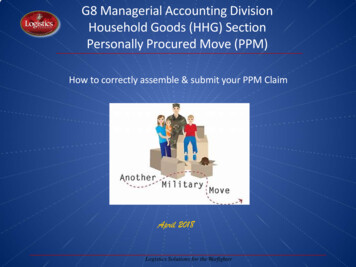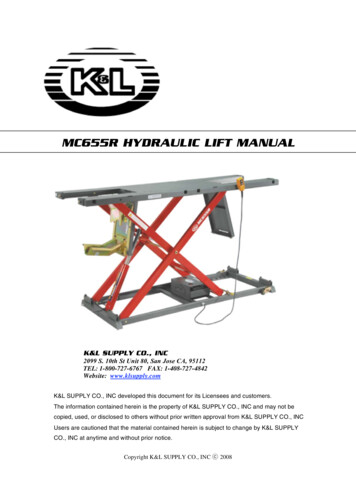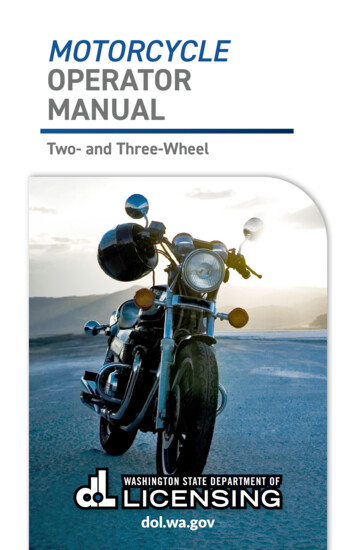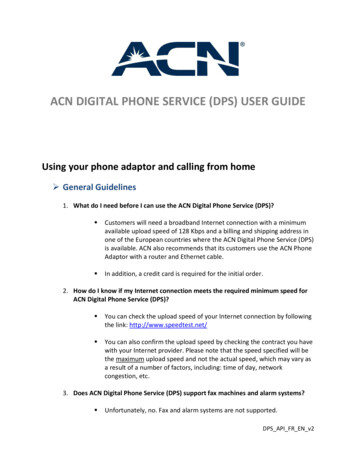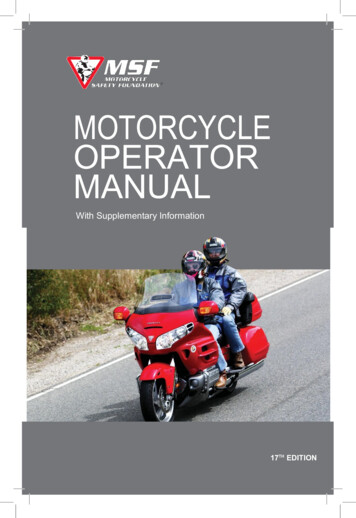
Transcription
MOTORCYCLEOPERATORMANUALWith Supplementary Information17TH EDITION
PREFACEWelcome to the Seventeenth Editionof the MSF Motorcycle Operator Manual(MOM). Operating a motorcycle safelyin traffic requires special skills andknowledge. The Motorcycle SafetyFoundation (MSF) has made this manualavailable to help novice motorcyclistsreduce their risk of having a crash. Themanual conveys essential safe ridinginformation and has been designedfor use in licensing programs. Whiledesigned for the novice, all motorcyclistscan benefit from the information thismanual contains.The original Motorcycle OperatorManual was developed by the NationalPublic Services Research Institute (NPSRI)under contract to the National HighwayTraffic Safety Administration (NHTSA)and within the terms of a cooperativeagreement between NHTSA and theMSF. The manual and related testswere used in a multi-year study ofimproved motorcycle operator licensingprocedures, conducted by the CaliforniaDepartment of Motor Vehicles undercontract to NHTSA.The purpose of this manual is toeducate riders and to help them avoidcrashes while safely operating eithera standard two-wheel motorcycle or athree-wheel motorcycle.This latest edition has undergonesignificant improvements, and containsnew, more in-depth information,designed to: Guide riders in preparing to ridesafely Develop effective street strategies Give riders more comprehensiveunderstanding of safe group ridingpractices Describe in detail best practices forcarrying passengers and cargoIn promoting improved licensingprograms, the MSF works closely withstate licensing agencies. The Foundationhas helped more than half the statesin the nation adopt the MotorcycleOperator Manual for use in theirlicensing systems.Improved licensing, along with highquality motorcycle rider education andincreased public awareness, has thepotential to reduce crashes. Staff atthe Foundation are available to assistgovernmental and private agencies inefforts to improve motorcycle safety.Tim BuchePresident,Motorcycle Safety Foundationmsf-usa.org
THE TOP FIVE REASONS MOTORCYCLISTS CRASHON UTAH HIGHWAYS BASED ON 2014 STATISTICSPROVIDED BY THE UTAH DEPARTMENT OFPUBLIC SAFETY’S HIGHWAY SAFETY OFFICE:1. Speed too Fast (12%)2. Failed to Keep in Proper Lane (11.2%)3. Followed too closely (11.1%)4. Other Improper Driving (8.3%)5. Swerved or Evasive Action (5.8%)
CONTENTSMOTORCYCLING IN UTAH .UT1THE RIDER ANDTHE MOTORCYCLE . 4PREPARING TO RIDEWear the Right Gear 5Know Your Motorcycle . 7Know Your Responsibilities . 10RIDE WITHIN YOUR ABILITIESBasic Vehicle Control . 11Keeping Your Distance . 15SEE . 20Intersections . 21Increasing Conspicuity . 24BEING IN SHAPE TO RIDEWhy This Information IsImportant . 42Alcohol and Other Drugs inMotorcycle Operation . 42Alcohol in the Body . 42Alcohol and the Law . 44Minimize the Risks . 44Step in to Protect Friends. 45Marijuana andMotorcycle Operation . 45Fatigue . 46EARNING YOUR LICENSE . 47THREE-WHEEL SUPPLEMENTCrash Avoidance . 27Supplementary Informationfor Three-Wheel Motorcycles. 49Handling Dangerous Surface. 30Know Your Vehicle . 49Mechanical Problems . 33Basic Vehicle Control . 51Animals . 34Carrying Passengers and Cargo . 54Flying Objects . 35Getting Off the Road . 35Carrying Passengersand Cargo . 35Group Riding . 38HAND SIGNALS . 55T-C LOCS PRE-RIDE CHECKLIST. 57
MOTORCYCLING IN UTAHMotorcycling is a very popular form of recreation as well astransportation for thousands of residents through the BeehiveState. Riding is fun, exciting, and challenging, but it has its risksbecause riders are exposed and vulnerable. The greatestchallenge you face when riding is to avoid accidents and injury.The basic content of this motorcycle operator manual has beendeveloped and provided by the Motorcycle Safety Foundation,and discusses motorcycle operations in general. This sectioncontains information pertaining specifically to motorcycling in theState of Utah, and is only a part of what every good motorcyclerider should know. This section condenses or paraphrases theactual language of the Utah Traffic Code. We hope thisinformation will help you enjoy riding and meet the challengesevery rider faces on our streets and highways.REQUIRED EQUIPMENTEvery motorcycle and every other type of motor-driven cycle(bicycles with motors, etc.) shall be equipped with the followingitems: One head lamp; One tail lamp; Either a tail lamp or separate lamp to illuminate the rearlicense plate with a white light; One red reflector on the rear; One stop lamp; A braking system; A horn or warning device; A muffler and emission control system which complieswith Utah requirements; A mirror; Depth of tire tread no less than 2/32 inch; Foot rests for any passenger; Handlebars not higher than shoulder height; and All motorcycles manufactured after January 1, 1973must be equipped with turn signalsIt is unlawful for a person to operate a motor vehicle upon Utahhighways unless the vehicle is in safe and good mechanicalcondition and all required equipment is in good working order.UT1
PROTECTIVE HEADGEAR (HELMETS)Everyone is encouraged to always wear an approved helmetwhen riding a motorcycle. It is against the law for anyoneunder the age of 21 to operate or ride a motorcycle, or anytype of motor-driven cycle, upon a public street or highway,unless he/she is wearing protective headgear whichcomplies with Federal standards.NOTE: A court shall waive 8 of a fine charged to a personoperating a motorcycle or motor-driven cycle for a movingtraffic violation if the person was 21 years of age or older atthe time of operation and wearing a protective headgearthat complies with DOT standards.SAFETY INSPECTIONSEffective January 1, 2018, safety inspections are no longerrequired for most vehicles, including all motorcycles/motordriven cycles. However, first-time, street-legal ATV registrationdoes require a safety inspection. For further information, contactthe Utah Dept. of Motor Vehicles.REGISTRATIONUnless exempted, a person may not operate a motorcycle inUtah unless it has been registered in accordance with Utahstatutes. Utah registration is required for any motor vehiclewithin sixty days of the owner-establishing residency in thisState.Residency in Utah is established when an individual hasestablished a domicile in the State; remains in the State for aperiod of six months or more during any calendar year; engagesin a trade, profession, or occupation in the State; or acceptsemployment in other-than-seasonal work and does not commuteinto the State.INSURANCEYou may be required to state, in writing, or present otherreasonable evidence, that you, (not the bank, loan company orlien holder) have owner’s insurance (or similar security) in effectat the time of registering, or obtaining license plates for yourmotorcycle. The law also states that any person operating amotorcycle shall have in his/her immediate possession evidenceof insurance for that vehicle. Failure to provide proof ofinsurance when requested by a peace officer can result inhaving to surrender your driver license. Any additional violationsof this law can result in having to surrender the registration foryour vehicle.UT2
LICENSE“License” means the privilege to drive a motor vehicle. “Licensecertificate” (usually referred to as a driver license) means theevidence of the privilege issued to drive a motor vehicle.Utah law requires that everyone operating a motorcycle on Utahpublic roads and highways must have in his/her possession avalid driver license with an endorsement for operatingmotorcycles. A temporary learner permit can be issued if theapplicant is at least 16 years old, and has a valid Class D orCommercial Driver License and has passed the vision test andthe required motorcycle written test. To obtain a learner permit,you must go to a driver license office, complete the applicationprocess, and pay the fee. A learner permit is valid for sixmonths.For the first two months from the date a motorcycle learnerpermit is issued, the operator of a motorcycle who holds amotorcycle learner permit may not: Operate a motorcycle on a highway with a postedspeed of 60 miles per hour or more,Carry passengers,Ride between the hours of 10 P.M. and 6 A.M.After holding a motorcycle learner permit for two months, thelearner permit holder may operate a motorcycle without theaforementioned restrictions imposed.NOTE: Anyone younger than 19 years old must hold themotorcycle learner permit for two months. The two-monthrequirement may be waived upon proof of completion of theBasic Rider Course (BRC). See page UT 15 for moreinformation.TIERED LICENSINGMotorcycle endorsements are issued based on a tiered system.The restriction will be determined by the size of the motorcycleused at the time of the skills test. If you test on a motorcycle 90 cc or less, you will berestricted to riding motorcycles 90 cc or less,*If you test on a motorcycle 249 cc or less, you will berestricted to riding motorcycles 249 cc or less*If you test on a motorcycle 649 cc or less, you will berestricted to riding motorcycles 649 cc or less*If you test on a motorcycle 650 cc or larger, you will notbe restricted.**Also applies to three-wheelers, and all motor-driven cyclesUT3
MOTORCYCLE SKILL TESTYou must provide your own motorcycle for the skills test at thedriver license office. The following diagrams represent the fourparts of the motorcycle skills test. Applicant must successfullycomplete all parts to obtain a motorcycle endorsement.UT4
NOTE: Due to space availability at certain driver licenseoffices, the test may be adjusted in some areas. Motorcycleskills tests are given by appointment only in most offices. Ifyou test on a three-wheeled motorcycle you will berestricted to riding only three-wheeled motorcycles.UT5
TRAFFIC RULES AND REGULATIONSAll operators of any motor vehicle, including motorcycles, mustcomply with the same traffic rules and regulations. Some itemsthat may be of specific interest to you are listed below for yourinformation. (All of the items pertain to motorcycles and motordriven cycles.) When operating a motorcycle, you must have in yourimmediate possession a valid driver license whichauthorizes operation of a motorcycle. When operating a motorcycle, you must have proof offinancial responsibility (insurance) in your immediatepossession. Motorcycles are permitted to use High OccupancyVehicle (HOV) Lanes. A person operating a motor vehicle in Utah isconsidered to have given his/her consent to a chemicaltest or tests for the purpose of determining whetherhe/she was operating the vehicle under the influence ofalcohol, any drug, or combination of alcohol and anydrug. Failure to comply with the request of a peaceofficer to take a test or tests will result in revocation ofdriving privileges. You must signal your intention to turn right or left, or tochange lanes, for at least TWO seconds beforebeginning the turn or lane change. Upon the approach of an authorized emergency vehicleusing audible (sirens, etc.) and/or visual signals(flashing lights, etc.), you must yield the right-of-way,and immediately move to the right-hand edge or curb ofthe road or highway and stop. You are to remainstopped until the emergency vehicle has passed. You cannot carry another person on a motorcycleunless it has been designed to carry more than oneperson. The passenger must ride upon the permanentand regular seat, if designed for two persons, or uponanother approved seat firmly attached to themotorcycle. The additional seat must not degrade orinterfere with the safe control of the motorcycle. Themotorcycle must also be equipped with footrests for thepassenger. It is unlawful to operate a motorcycle while carrying apackage, bundle, or other article which prevents youfrom keeping both hands on the handlebars. All motorcycles are entitled to full use of a lane. Generally, it is unlawful to ride a motorcycle betweenlanes of traffic or rows of vehicles, unless certainconditions have been met (see Lane Filtering onadjacent page). Motorcycles may not be operated more than twoabreast in a single lane. It is unlawful to throw any lighted material from amoving vehicle.UT6
Every vehicle shall be equipped, maintained andoperated in such a manner as to prevent excessiveand/or unusual noise.You may not overtake or pass in the same lane oftraffic or rows of vehicles.No person under 16 years of age, whether resident ornon-resident of Utah, may operate a motor vehicleupon any road or highway of the State. (Someexceptions to this rule do exist for off-highway vehiclesand for individuals with instruction or practice permits.)If a person has a change of address, they are required,by law, to notify the division of the new address withinTEN days. This may be done online or in person at anyfield office. When appearing at a field office, you mustprovide two (2) acceptable proofs of residency. This isimportant because the post office will not forward mailfrom the Driver License Division.An operator of a motorcycle, moped, or bicycle, who is16 years of age or older, may, after bringing the vehicleto a complete stop at the intersection or stop line anddetermines that the traffic-control signal has notdetected the operator’s presence by waiting areasonable period of time - and not less than 90seconds at the intersection or stop line - proceedacross the roadway if there are no other vehicles orpedestrians near the intersection.LANE FILTERINGWhile operating a motorcycle (other than an autocycle), theoperator may pass another vehicle stopped in the same directionof travel in the same lane when the following conditions exist: The individual is on a roadway divided into two ormore adjacent traffic lanes in the same direction oftravel, The individual is on a roadway with a speed limit of45 miles per hour or less, The vehicle being overtaken in the same lane isstopped, The motorcycle is traveling at a speed of 15 milesper hour or less, The movement may be made safely.UT7
(Lane Filtering)OFF-HIGHWAY VEHICLESThis section is included in the handbook for the many users ofoff-highway vehicles (OHV) in Utah. The following items are notall-inclusive and do not contain all pertinent information, but areprovided only as a guide for those who might be interested. Formore information regarding OHV rules, regulations, registrationinformation, etc., please contact the Utah Parks and RecreationDivision at 801-538-7433, or the web address ofwww.stateparks.utah.gov . Any person operating an OHV is subject to theprovisions of the Utah traffic Rules and Regulations,unless specifically excluded.OHV operators and passengers under 18 years of ageare required to wear properly fitted, safety ratedprotective headgear. It is recommended that everyoneriding an OHV wear a helmet.A person may not operate an OHV unless he/shepossesses a valid driver license issued by the DriverLicense Division or the appropriate safety certificateissued by the Division of Parks and Recreation.The Division of Parks and Recreation issue safetycertificates to individuals who successfully complete theOHV safety education and training program or pass theknowledge and skills test established.No person may operate or transport any OHV on anypublic land, trail, street or highway unless the OHV hasbeen registered for the current year.Out of state OHV operated with in the State of Utah arerequired to be registered in their home state. Any nonresident owning an OHV who operates or gives anotherUT8
person permission to operate the OHV on any publicland, trail, street, or highway in this state shall: Apply for an off-highway vehicle decal issuedexclusively for an OHV owned by a nonresident ofthe state;Pay an annual OHV user fee; andProvide evidence that the person is a non-resident,and the person is the owner of the OHV.NOTE: The above does not apply if the OHV is registered ina state that offers reciprocal operating privileges to Utahresidents or if OHV is used in a competitive event. It is unlawful for an OHV to be operated along, across,or within the boundaries of an interstate freeway orcontrolled-access highway.An OHV may not be operated on any street or highwaynot designated as open to OHV use, except whencrossing a street or highway; loading or unloading anOHV from a vehicle or trailer; or when an emergencyexists.Snowmobiles may be operated on streets or highwayswhich have been officially closed for the season toconventional motor vehicle traffic.No person shall operate an OHV upon privately ownedland without permission from the owner or a person incharge. It is unlawful to alter, deface or damage anyfence, gate or other enclosure.Registered OHV shall be equipped with: brakes adequate to control the movement of and tostop and hold the vehicle, headlights and taillights when the OHV is operatedbetween sunset and sunrise, a noise control device, and a safety flag when operated on sand dunes.CLARIFICATION: Motorcycle operators and passengersunder the age of 21 are required to wear protectiveheadgear on all public streets and highways. For offhighway use, all operators and passengers under the age of18 are required to wear protective headgear.UT9
Street-Legal All-Terrain VehiclesALL-TERRAIN TYPE I VEHICLES (ATVs)DefinitionAn all-terrain type I vehicle means any motor vehicle 52 inchesor less in width, having an unladen dry weight of 1,500 poundsor less, traveling on three or more low-pressure tires, having aseat designed to be straddled by the operator and designed for,or capable of travel over unimproved terrain.RegistrationA street-legal ATV is subject to a safety inspection the first timethat a person registers an off- highway vehicle as a street-legalall-terrain vehicle. A street-legal ATV will also need to complywith county motor vehicle emissions inspections andmaintenance programs.LicensingA street-legal ATV shall comply with the same requirements as amotorcycle as to following traffic rules, registering, titling,odometer statement, vehicle identification, license plates, andregistration fees.NOTE: If you have a Class D or CDL license you are licensedto drive a street-legal ATV; a motorcycle endorsement is notrequired.Highway UseATVs that meet the requirements may be operated as streetlegal ATVs on a street or highway that is a highway with onelane in each direction.NOTE: A street-legal ATV operating on a highway may notexceed the lesser of the posted speed limit or 50 miles perhour. If the street-legal ATV is operated on a highway with aposted speed limit higher than 50 miles per hour, theoperator shall ride the street-legal all-terrain vehicle on theextreme right hand side of the roadway, and shall equip thestreet legal all-terrain vehicle with a reflector or reflectivetape.RequirementsA street-legal ATV shall be equipped with: One or more headlamps; One or more tail lamps ; Either a tail lamp or a separate lamp to illuminate therear license plate with a white light; One or more red reflectors on the rear;UT10
One or more stop lamps on the rear;Amber or red electric turn signals, one on each sidefront and rear;A braking system, other than a parking brake;A horn or other warning device;A muffler and emission control system which complieswith Utah requirements;Rearview mirrors on the left side of the driver;A windshield, unless the operator wears eye protectionwhile operating the vehicle;A speedometer, illuminated for nighttime operation;For carrying passengers a seat designed forpassengers, a footrest, and handholds for eachpassenger. For vehicles designed with side-by-sideseating, seatbelts are required for each passenger; andTires that do not exceed 26 inches in height, are notlarger than the tires that the all-terrain vehiclemanufacturer made available for the all-terrain vehicleand have at least 2/32 inches or greater tire treadALL-TERRAIN TYPE II VEHICLESDefinitionAn all-terrain type II vehicle means any motor vehicle 80 inches orless in width, traveling on four or more low-pressure tires, havinga steering wheel, non-straddle seating, a rollover protectionsystem, and designed for or capable of travel over unimprovedterrain, and is: An electric-powered vehicle, or A vehicle powered by an internal combustion engine andhas an unladen dry weight of 2,500 pounds or less.RegistrationA street-legal all-terrain type II vehicle is subject to a safetyinspection the first time that a person registers an off- highwayvehicle as a street-legal all-terrain vehicle. A street- legal allterrain type II vehicle will also need to comply with county motorvehicle emissions inspections and maintenance programs.LicensingThe street-legal all-terrain type II vehicle shall comply with thesame requirements as a motorcycle as to following traffic rules,registering, titling, odometer statement, vehicle identification,license plates, and registration fees.NOTE: If you have a Class D or CDL license you arelicensed to drive a street-legal all-terrain type II vehicle; amotorcycle endorsement is not required.UT11
Highway UseAll-terrain type II vehicles that meet the requirements may beoperated as street-legal all-terrain type II vehicles on a street orhighway that is a highway with one lane in each direction.NOTE: A street-legal all-terrain vehicle operating on ahighway may not exceed the lesser of the posted speedlimit or 50 miles per hour. If the street-legal all-terrainvehicle is operated on a highway with a posted speed limithigher than 50 miles per hour, the operator shall ride thestreet-legal all-terrain vehicle on the extreme right hand sideof the roadway and shall equip the street legal all-terrainvehicle with a reflector or reflective tape.RequirementsA street-legal ATV shall be equipped with: One or more headlamps; One or more tail lamps ; Either a tail lamp or a separate lamp to illuminate therear license plate with a white light; One or more red reflectors on the rear; One or more stop lamps on the rear; Amber or red electric turn signals, one on each sidefront and rear; A braking system, other than a parking brake; A horn or other warning device; A muffler and emission control system which complieswith Utah requirements; Rearview mirrors on the left side of the driver; A windshield, unless the operator wears eye protectionwhile operating the vehicle; A speedometer, illuminated for nighttime operation; For carrying passengers a seat designed forpassengers, a footrest, and handholds for eachpassenger. For vehicles designed with side-by-sideseating, seatbelts are required for each passenger; and Tires that do not exceed 26 inches in height, are notlarger than the tires that the all-terrain vehiclemanufacturer made available for the all-terrain vehicleand have at least 2/32 inches or greater tire treadAll-Terrain Type IAll-Terrain Type IIUT12
What is a motorcycle?A motorcycle is a motor vehicle, other than a tractor, having aseat or saddle for the use of the rider and designed to travel withnot more than three wheels in contact with the ground. UtahTraffic Code 41-6a-102 (35)Two Wheeled MotorcycleThree-Wheeled MotorcycleA driver license and a motorcycle endorsement are required toride a motorcycle on public roads and lands.NOTE: The motorcycle endorsement may have a restrictiondepending on the size of motorcycle the rider is tested on.See Page UT 3 Tiered LicensingWhat is a motor-driven cycle?A motor-driven cycle is a motorcycle, motor scooter, moped,electric assisted bicycle, motor assisted scooter, and everymotorized bicycle having an engine with less than 150 cubiccentimeters displacement, or a motor which produces notmore than 5 horsepower.A driver license and motorcycle endorsement is required to ridea smaller motorcycle or a motor scooter. In some other states, asmall motor scooter is sometimes called a moped.NOTE: The motorcycle endorsement may have a restrictiondepending on the size of motorcycle the rider is tested on.See page 3 Tiered Licensing.UT13
What is a motorized bicycle?There are two types of motorized bicycles, defined in Utah’sTraffic Code section 41-6a-102. Moped – A motor-driven cycle having pedals to permitpropulsion by human power and a motor whichproduces not more than two brake horsepower. Themotor is not capable of propelling the cycle at a speedin excess of 30 MPH on level ground. If an internalcombustion engine is used, the displacement may notexceed 50 cubic centimeters and the moped shall havea power drive system that functions directly orautomatically without clutching or shifting by the riderafter the drive system is engaged. Electric Assisted Bicycle – An electric assistedbicycle is a bicycle with an electric motor that has apower output of not more than 750 watts, has fullyoperable pedals on permanently fixed cranks, and isfully operable as a bicycle without the use of the electricmotor. Electric assisted bicycles fall into three classes:Class 1 - Provides assistance only when therider is pedaling, and ceases to provideassistance when the bicycle reaches the speedof 20 miles per hourClass 2 - Equipped with a motor that may beused exclusively to propel the bicycle, and is notcapable of providing assistance when thebicycle reaches the speed of 20 miles per hour.Class 3 - Provides assistance only when therider is pedaling, ceases to provide assistancewhen the bicycle reaches the speed of 28 milesper hour, and is equipped with a speedometer. A driver license is required to operate a moped, but, amotorcycle endorsement is not. A driver license is not requiredto operate an electric assisted bicycle; however, the followingrestrictions apply: An individual under 16 years of age may notoperate a class 3 electric assisted bicycle, An individual under 14 years of age may notUT14
operate an electric assisted bicycle with theelectric motor engaged on any public property,highway , path, or sidewalk unless theindividual is under the direct supervision oftheir parent or guardian, An individual under eight years of age may notoperate an electric assisted bicycle with theelectric motor engaged on any public property,highway, path, or sidewalkWhat is a motor-assisted scooter?A motor assisted scooter is a self-propelled device with at leasttwo wheels in contact with the ground, a braking system capableof stopping the unit under typical operating conditions, and anelectric motor not exceeding 2000 watts. It must also have eitherhandlebars and a deck designed for a person to stand on whileoperating the device; handlebars and a seat designed for aperson to sit, straddle, or stand while operating the device; adesign for the ability to be propelled by human power alone; anda maximum speed of 20 miles per hour on a paved levelsurface.A person may not operate a motor assisted scooter: In a public parking structure; On public property posted as an area prohibitingbicycles; In a crosswalk in a negligent manner; While carrying more people at one time than thenumber for which it is designed; That has been structurally or mechanically altered fromthe original manufacturer’s design; or At a speed greater than 15 miles per hour.A driver license is not required to operate a motor assistedscooter. An owner may not authorize or knowingly permit aperson under the age of 18 to operate a motor assisted scooterin violation of Traffic Code 41-6a-1115. A person under 8 yearsof age may not operate a motor assisted scooter with the motorrunning on any public property, highway, path, or sidewalk.Note: Local authorities may pass ordinances regulating theuse of motor assisted scooters on public properties,sidewalks, and roadways. Always check with your cityUT15
officials for current ordinances before you ride.For more information, please refer to Traffic Code 41-6a-1115.What is an electric personal assistive mobility device?An electric personal assistive mobility device is a self-balancingdevice with: Two non-tandem wheels in contact with the ground; A system capable of steering and stopping the unitunder typical operating conditions; An electric propulsion system with average power ofone horsepower or 750 watts; and A maximum speed capacity on a paved, level surfaceof 12.5 miles per hour. This does not include awheelchair.A driver license is not required to operate an electric personalassistive mobility device.What is a mini-motorcycle/pocket bike?A mini-motorcycle is a motor-driven cycle that has a seat orsaddle that is less than 24 inches from the ground as measuredon a level surface with properly inflated tires. A mini-motorcycledoes not include a moped or motor assisted scooter, or amotorcycle that is designed for off-highway use and registeredas an off-highway vehicleA person may not operate a mini-motorcycle on any publicproperty, highway, path, or sidewalk unless the mini-motorcycleis registered for highway use and the operator is licensed tooperate a motorcycle.Note: Many cities in Utah have passed ordinances forbiddingmini-motorcycles from being driven on city streets. Checkwith your city for more information.UT16
What is an autocycle?An autocycle mean a motor vehicle that is designed
Welcome to the Seventeenth Edition of the MSFMotorcycle Operator Manual (MOM). Operating a motorcycle safely in traffic requires special skills and
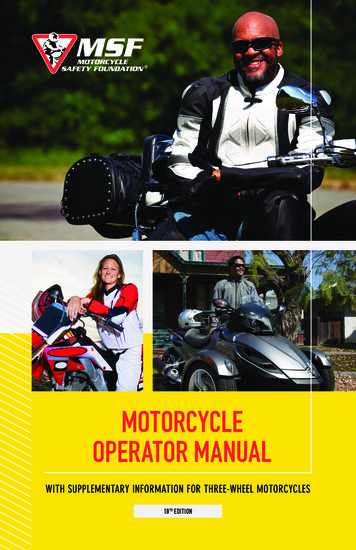
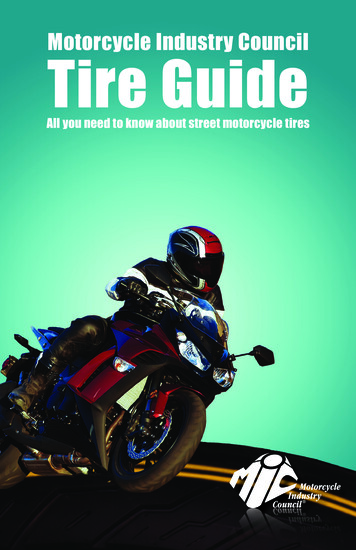
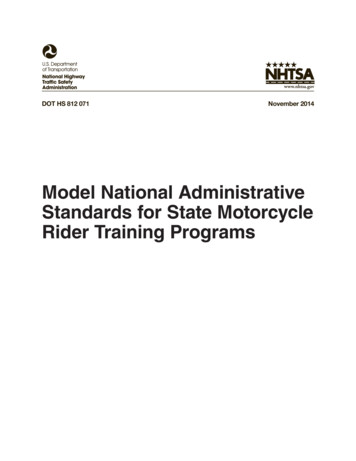
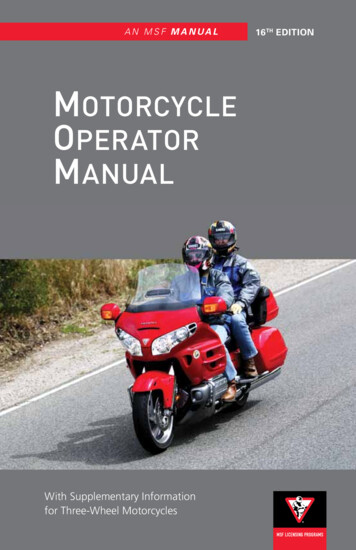

![Motorcycle Mechanic [MM] - CTEVT](/img/5/motorcycle-20-20mechanic-2010.jpg)

